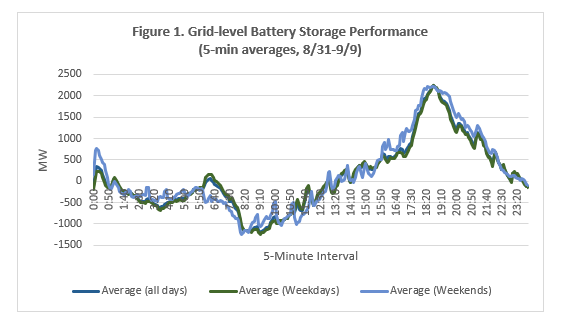July 15, 2021 By Sergio Dueñas and Lily Backer
Energy Storage Beat the Heat And It Can Do Much More
A Historic Challenge
September 15, 2022
Sergio Dueñas, Policy Manager
Last week, the Golden State’s energy grid faced its most grueling operational conditions since August 2020, when a combination of factors drove the California Independent System Operator (CAISO) to utilize rolling blackouts to maintain grid stability and avoid additional outages. Like in 2020, the late summer’s high temperatures drove energy demand to historic highs. This time however, California avoided insufficiency since it counted with around 3,500 megawatts (MWs) of utility-scale energy storage to maximize the use of its renewable energy resources like wind and solar power and keep California’s grid operating through the periods of highest demand.
The risks California confronted last week are novel and complex and have seldom been incorporated into grid planning scenarios and methodologies. In order to maintain reliable electric service, demand and supply must be equal at all times. In this context, a particular challenge has to do with the grid’s ability to meet demand in the hours immediately following the peak hour, when demand is still high, but solar generation rapidly decreases in late afternoon. In order to meet this demand, CAISO requires responsive resources that can rapidly ramp their output. To date, this need has been met primarily through the use of fossil fuel generation, such as natural gas plants, but this approach is suboptimal as it runs counter to California’s ambitious climate goals. Enter energy storage – a technology class that can responsively meet grid needs and that, with proper market incentives, does so with zero-carbon generation.
Entering the most difficult week of 2022, the expectations surrounding energy storage were clear: the world’s largest collection of utility-scale lithium-ion batteries would have to absorb energy in the periods of low demand and inject it back into the grid when customers require it most. Looking at the 5-minute data covering August 31st through September 9th, the 10 consecutive days where the CAISO issued voluntary conservation alerts (Flex Alerts) demonstrates storage did precisely what it was expected to. On average, the CAISO storage fleet charged in the middle of the night and in the morning hours prior to noon. It later discharged for a significant period of time, remaining a net discharger from 3 to 10 PM.

Energy Storage Delivers
This performance is incredible and proof that large amounts of grid-scale energy storage can be effectively operated and optimized, and that these resources can significantly contribute to reliability and align to decarbonization goals and customer interests. It is also a clear indication that the coordinated efforts of industry, load-serving entities, regulators, and market operators to bring these technologies to reality have yielded material benefits to all Californians. CAISO CEO Elliot Mainzer recognized the operation of these assets, noting on September 8th that “[I]n general, the battery storage fleet performance has been outstanding.”
Of the 10 consecutive days of Flex Alert, September 5th through 7th proved to be the most difficult days for the CAISO. A combination of high temperatures, wildfire impacts, and lost generation forced the market operator to issue Energy Emergency Alerts (EEA) 2 and 3 for these days. A closer look at solar and storage operations shows that storage is responsive to the availability of solar and its effects on locational marginal prices (LMPs). On both September 5th and 7th, when solar levels were similar and relatively high, storage performance was also similar: holding state-of-charge in anticipation of higher prices later in the day. On September 6th, in contrast, when solar was significantly lower between noon and 4 PM, solar may not have been the marginal resource in a number of nodes, a situation that would push LMPs higher. In response to this rise in price, some storage resources in nodes with higher-than-normal LMPs discharged hours before the peak period. This is compounded by the fact that, in the real-time market, storage resources are optimized considering the conditions and prices of the next 65 minutes, not the rest of the day.

Lessons Learned
Battery storage performance through the September 2022 heatwave underscores the systemwide benefits of investing in energy arbitrage technologies, but it also demonstrates that more can be done to optimize storage across the CAISO footprint in order to unlock the full potential of these assets. The operational data from September 6th shows that storage’s responsiveness to local conditions and price signals could be leveraged to a greater extent. By incorporating local planning explicitly into planning venues, California could enable a more resilient grid that would limit the impact of demand spikes or generation losses within load pockets. This way, storage could be proactively deployed at substations or local areas that could be prone to insufficiency, providing a line of resilience in addition to voluntary conservation.
CAISO also underscored that voluntary conservation played a significant role last week (reportedly on the order of 2,000 MW or more) and this could also be improved by better operationalizing energy storage. Today there are thousands of behind-the-meter (BTM) storage systems, many of them paired with rooftop solar generation, that offer dependable rate management to customers and are more responsive and reliable than voluntary conservation efforts. Despite the fact that these resources are physically able to reduce load and even export to the grid, these assets have not been fully utilized and are still equated to conventional demand response strategies. Leveraging and co-optimizing the capabilities of these assets would not only yield resiliency benefits for customers and communities, but also offer significant ratepayer benefits by obviating the need to retain old, inefficient power plants. In Year 2 of the Emergency Load Reduction Program (ELRP), adopted by the California Public Utilities Commission (CPUC) in March 2021, CESA has anecdotally heard about the multiple dispatches and calls for enrolled resources in responding to grid emergencies, which are inclusive of the exports provided by BTM storage assets. We look forward to seeing the results, which could show how, rather than relying on uncompensated and voluntary conservation, planned BTM storage resources should be compensated to commit and deliver in case of emergency, easing the stress of the CAISO in hoping the state has enough resources to meet demand.
California now has the opportunity to further demonstrate how valuable storage can be in advancing a more affordable, efficient, reliable, safe and sustainable electric power system for all its citizens. Last week storage demonstrated it can ride out a heatwave; let’s show the world it can do much more.



